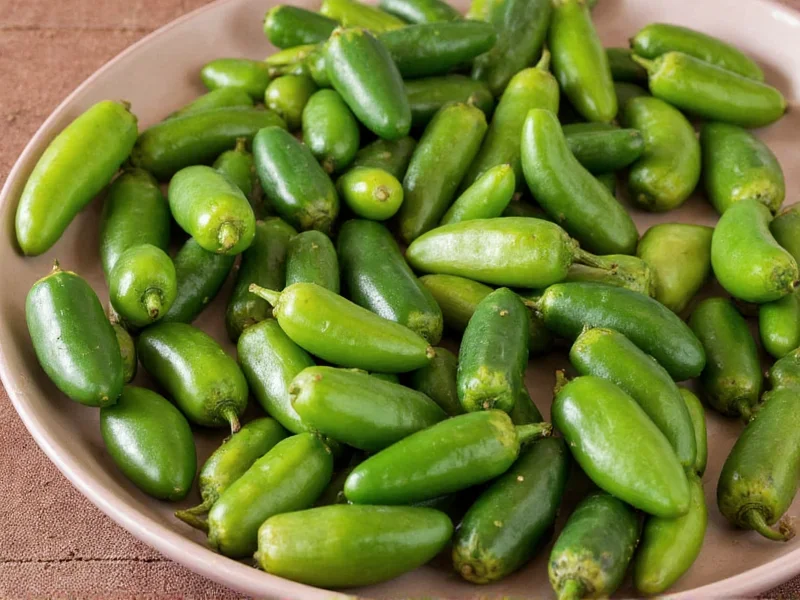Understanding exactly where jalapeños fall on the Scoville scale helps home cooks and culinary professionals select the right peppers for their recipes. The Scoville scale, developed by pharmacist Wilbur Scoville in 1912, measures the concentration of capsaicinoids—the compounds responsible for a pepper's heat. While jalapeños are among the most popular chili peppers worldwide, their heat can vary significantly based on multiple factors.
What Determines Jalapeño Heat Levels?
Jalapeño heat isn't consistent across all specimens. Several key factors influence where a particular jalapeño falls within the 2,500-8,000 SHU range:
- Ripeness: Green jalapeños (less ripe) tend to be milder, while red jalapeños (fully ripe) often deliver more heat
- Growing conditions: Soil composition, water availability, and sunlight exposure significantly impact capsaicin production
- Stress factors: Peppers grown under moderate stress (like limited water) typically develop higher capsaicin levels
- Varietal differences: Some jalapeño cultivars are specifically bred for milder or hotter profiles
- Seed and membrane content: The white pith and seeds contain the highest concentration of capsaicin
Comparing Jalapeños to Other Common Peppers
| Pepper Type | Scoville Heat Units (SHU) | Heat Level Comparison |
|---|---|---|
| Bell Pepper | 0 SHU | 0 times jalapeño heat |
| Jalapeño | 2,500-8,000 SHU | 1x (baseline) |
| Serrano | 10,000-23,000 SHU | 2-3x hotter than jalapeño |
| Habanero | 100,000-350,000 SHU | 15-40x hotter than jalapeño |
| Ghost Pepper | 855,000-1,041,427 SHU | 100-130x hotter than jalapeño |
Practical Implications for Cooking
Knowing the jalapeño scoville range helps you make informed decisions in the kitchen. For those sensitive to spice, removing the seeds and white membranes can reduce heat by up to 80% since these parts contain the highest concentration of capsaicin. When substituting jalapeños in recipes, consider that a single serrano pepper may require using two or three jalapeños to achieve similar heat levels.
Chefs often use the jalapeño's moderate heat to add flavor complexity without overwhelming other ingredients. The pepper's bright, grassy notes complement Mexican cuisine while its manageable heat makes it accessible to most palates. For canning or pickling, jalapeños maintain their structure well while infusing vinegar-based solutions with subtle heat.
Measuring Pepper Heat Accurately
While the Scoville scale remains the standard reference, modern laboratories use High-Performance Liquid Chromatography (HPLC) to measure capsaicinoid concentration more precisely. This scientific method provides objective measurements that have largely replaced the original subjective human tasting panels Scoville used.
When shopping for jalapeños, look for firm, bright green specimens without wrinkles or soft spots. The heat level isn't always apparent from appearance alone, but peppers with more visible striations (white lines) often indicate higher stress during growth and potentially greater heat. For consistent heat in recipes, consider purchasing from the same source each time, as growing conditions vary significantly between farms.
Safety Tips for Handling Hot Peppers
Even mild peppers like jalapeños can cause skin irritation. Always wear gloves when handling large quantities, and never touch your face while working with peppers. If you experience burning sensations, dairy products like milk or yogurt provide immediate relief as casein binds to capsaicin. Avoid using water, which spreads the oil rather than neutralizing it.
Understanding Scoville Ratings in Context
The jalapeño scoville measurement range reflects natural variation rather than inconsistency in testing methods. Unlike standardized products, agricultural products like peppers vary due to environmental factors. This natural variation explains why one jalapeño might seem mild while another from the same plant delivers significant heat.
When following recipes specifying jalapeños, consider tasting a small piece first to gauge its actual heat level. This practical approach accounts for the natural variation in jalapeño scoville units and helps prevent unexpectedly spicy dishes. For competitive eating or extreme heat challenges, always have dairy products nearby and know your personal heat tolerance limits.
What is the average scoville rating for a typical jalapeño pepper?
The average jalapeño pepper measures approximately 5,000 Scoville Heat Units (SHU), though they naturally range from 2,500 to 8,000 SHU. This places them solidly in the mild to medium category of the Scoville scale, making them versatile for various culinary applications without overwhelming heat.
Why do some jalapeños taste much hotter than others?
Jalapeño heat variation stems from multiple factors including growing conditions, water stress, ripeness, and genetic differences between plants. Peppers grown with less water typically develop higher capsaicin levels as a defense mechanism. The white pith and seeds contain the highest concentration of capsaicin, so how these parts are handled during preparation significantly affects perceived heat.
How does the jalapeño scoville scale compare to other common peppers?
Jalapeños (2,500-8,000 SHU) are significantly milder than serranos (10,000-23,000 SHU), which are about 2-3 times hotter. They're much milder than habaneros (100,000-350,000 SHU), which range from 15-40 times hotter. Compared to bell peppers (0 SHU), jalapeños provide noticeable heat while remaining accessible to most palates.
Can I reduce the heat of jalapeños for sensitive eaters?
Yes, removing the seeds and white membranes (placenta) can reduce a jalapeño's heat by up to 80% since these parts contain the highest concentration of capsaicin. Soaking sliced peppers in salt water or milk for 15-30 minutes can also draw out some capsaicin. For extremely sensitive palates, consider using only the outer green flesh while discarding all internal structures.
Does the color of a jalapeño affect its scoville rating?
Yes, color indicates ripeness which affects heat. Green jalapeños (less ripe) typically fall at the lower end of the scoville range (2,500-5,000 SHU), while red jalapeños (fully ripe) often reach the higher end (5,000-8,000 SHU). Riper peppers develop more capsaicin as they mature, though they also develop sweeter flavor notes that can balance the heat perception.











 浙公网安备
33010002000092号
浙公网安备
33010002000092号 浙B2-20120091-4
浙B2-20120091-4